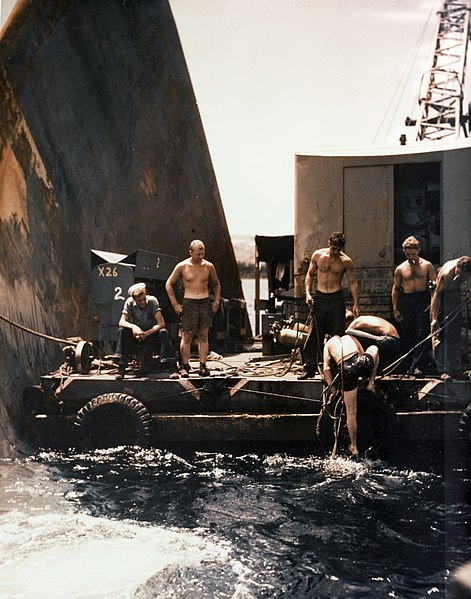Burgettstown, PA – June 5th – NAVY DIVER
NAVY DIVER – June 5th – Burgettstown, PA
The history of deep underwater diving started with freediving as a widespread means of hunting and gathering, both for food and other valuable resources such as pearls and coral. By Greek and Roman times, commercial applications such as sponge diving and marine salvage were established. Military diving also has a long history, going back at least as far as the Peloponnesian War, with recreational and sporting applications being a recent development. Technological development in ambient pressure diving started with stone weights (skandalopetra) for fast descent. In the 16th and 17th centuries diving bells became functionally useful when a renewable supply of air could be provided to the diver at depth, and progressed to surface supplied diving helmets—in effect miniature diving bells covering the diver’s head and supplied with compressed air by manually operated pumps—which were improved by attaching a waterproof suit to the helmet, and in the early 19th century became the standard diving dress.
History of Navy Divers
Since the middle of the nineteenth century, the U.S. Navy has used divers on the salvage and repair of ships, construction, and other military operations. During the Civil War’s Battle of Mobile Bay, swimmers were sent ahead of Adm. David Farragut’s ships to locate and disarm Confederate mines, and in 1898, Navy divers investigated the mysterious explosion of USS Maine while anchored in the harbor of Havana, Cuba. Navy divers were quickly engaged in World War II as the Japanese attacked Pearl Harbor. By 09:15 on December 7, 1941, salvage teams were already at work cutting through the hull of an overturned battleship, the USS Oklahoma, in an attempt to save sailors trapped inside the ship. Salvage operations were not the only missions assigned to Navy divers during the war. Many dives were made to inspect sunken enemy ships in an attempt to recover intelligence. The Navy’s Underwater Demolition Teams (UDT) were created when bomb disposal experts and Seabees (combat engineers) teamed together in 1943 to devise methods for removing obstacles the Germans were placing off the beaches of France. In the Pacific, the first combat mission for UDT’s was a daylight reconnaissance and demolition project off the beaches of Saipan in June 1944. During the Battle of Okinawa, one UDT removed 1,200 underwater obstacles in two days, under heavy fire, without a single casualty.
Navy Divers even have a relationship to Pittsburgh.
On June 4, 1945 the USS Pittsburgh was caught in Typhoon Viper which increased to 70-knot (130 km/h) winds and 100-foot (30 m) waves. Her starboard scout plane was lifted off its catapult and dashed onto the deck by the wind, then shortly after her second deck buckled. Her bow was thrust upward, then sheared off, but there were no casualties. Still fighting the storm, and maneuvering to avoid being hit by her drifting bow structure, Pittsburgh was held quarter-on to the seas by her engine power while the forward bulkhead was shored. After a seven-hour battle, the storm subsided, and Pittsburgh proceeded at 6 knots (11 km/h) to Guam, arriving on 10 June. Her bow, nicknamed “McKeesport” (a suburb of Pittsburgh), was later salvaged by the tugboat USS Munsee and brought into Guam. The 104-foot section of bow broke off owing to poor plate welds at the Bethlehem Shipbuilding Co. at the Fore River Shipyard, Quincy, Massachusetts. The typhoon damage also earned her the nickname “Longest Ship in the World” as thousands of miles separated the bow and stern. Navy divers were key to the rescue and repair of the Pittsburgh, but that battered cruiser would not sail again in WWII. Her repairs completed, she was placed in reserve and decommissioned on 7 March 1947.

Photo: Naval History & Heritage Command, Public domain, via Wikimedia Commons
Sources:
https://www.history.navy.mil/browse-by-topic/communities/divers.html
https://en.wikipedia.org/wiki/History_of_underwater_diving
https://en.wikipedia.org/wiki/USS_Pittsburgh_(CA-72)
